|
Paper 29
Skillern & Challoner, Music Sellers, c.1806-1825
Contributed by Paul Cooper, Research Editor
[Published - 15th September 2017, Last Changed - 5th September 2023]
Thomas Skillern and his brother-in-law, Neville Butler Challoner, ran a successful music publishing shop in London in the early 19th century, c.1806 to 1825. They published the music for Country Dances, Stage Dances, and Quadrilles, and were credited as a music supplier to the Regency era Dancing Master Thomas Wilson. In this paper we'll consider their contributions to social dance history over around 20 years of publishing, together with some of their more interesting publications.

Figure 1. August 1st 1806, Print accompanying a Song, music for which was sold by Skillern & Challoner. Courtesy of the Lewis Walpole Library, Yale.
Skillern & Challoner, a brief History
Thomas Skillern (Junior, 1776-1849) inherited the publishing firm of his Uncle, Thomas Skillern (Senior), on his Uncle's death in 1800. His Uncle's business had been one of London's major music publishers since the 1760s, the younger Thomas had served as an apprentice under his Uncle from 1790. Doane's 1794 Musical Directory lists two musical Skillerns at the same address, one is readily identified as the Uncle, the other is listed as a player of the Violin at the grand performances at Westminster Abbey, and at Ranelagh Gardens; this is presumably our Thomas Skillern. If so, he was admitted to the Royal Society of Musicians in 1799. The Biographical Dictionary of Actors, Actresses, Musicians, Dancers, Managers and Other Stage Personnel (Highfill, et. al.) report that he regularly played at the society's concerts and at the Theatres until 1822.
Thomas Skillern (Senior) died in 1800, his Will is available through the National Archives. He appears to have died childless, most of his estate was split between his niece Melina Skillern and his nephew Thomas Skillern; Melina was bequeathed a large quantity of cash, including Sixty three Guineas or fifty two pounds four shillings , whereas Thomas was left all my stock in trade . It appears that the firm's assets were liquidated shortly thereafter, it's reported that much of the Skillern music plates were transferred (presumably sold) to the rival business of Thomas Preston c.1803 (Exeter Working Papers in Book History), leaving the inherited business dormant and potentially abandoned.
On April 8th 1805 Melina Skillern was married to Neville Butler Challoner at St Anne's Soho. The two brothers-in-law evidently went into partnership together, forming the company of Skillern & Challoner around 1805, certainly no later than 1806. Figure 1 shows an image from a Song sheet Publish'd Augt. 1, 1806, by Laurie & Whittle , it indicates that the associated musical score was available from Skillern & Challoner; the business clearly existed by that date. Neville Butler Challoner (1784-1851) went on to become a successful composer and musician; he published music through their shared business, and was himself elected to the Royal Society of Musicians in 1806.
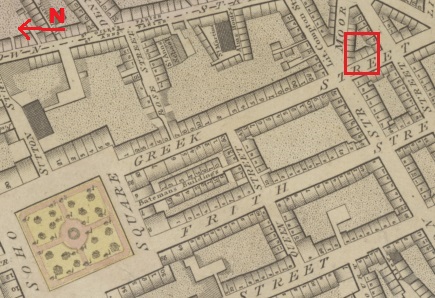
Figure 2. 25 Greek Street, Soho, from the Horwood map of 1792-9. © THE BRITISH LIBRARY BOARD, HUS 050.
The firm was variously known as Skillern & Challoner and Skillern & Co.. Both names were used interchangeably, though Challoner's name was often absent from their later publications, perhaps hinting that he became less involved over time. Their music warehouse was located at new premises at 25, Greek Street, Soho, removed from corner of St. Martin's Church Yard (see Figure 2), this address was printed on their publications until at least mid 1815. By March of 1816 (Morning Post, 6th May 1816; and insurance records) they had moved to 138, Oxford Street, opposite the Mona Marble Works , remaining there until at least January 1818 (Morning Post, 30th January 1818). By mid 1819 the address had moved to Regent Street, 2 doors down from Regent's-circus, Oxford-Street (The Times, 17th July 1819), in 1823 this same address was described as 247, Regent-street, Oxford-street (The Times, 31st March 1823).
A c.1816 Catalogue of Sonata's &c. attached to their 1st Set of The Favorite French Quadrilles lists some of the works available through their shop. This included works by Beethoven, Challoner, Dussek, Ling, Nicolais, Steibelts, Clementi, Graun, Haydn, Venua, Mozart, Latour, Kreitzer, Reeve, Corri, Neville, Gildon and Butler. None of these composers (with the possible exception of Challoner himself) published through them exclusively, but they had purchased rights to some important works.
The business finally closed in 1825. Their valuable copyrights, publishing plates, stock and even waste paper were advertised to be auctioned off on Friday 23rd September 1825 (Morning Advertiser, 19th September 1825, see Figure 3): The genuine and entire Stock in Trade of Messrs Skillern and Challoner (leaving business), consisting of several thousand plates of valuable copyrights and other established works; a very large quantity of vocal and instrumental music and waste paper, pianofortes, harps, guitars, violins, flutes, and the several articles connected with that branch of business. May be viewed the 21st and 22nd September. Catalogues may be had on the premises; and of the auctioneer .
Some of their publications have survived with a label indicating Sold at MITCHELL's Musical Library & Instrument Warehouse pasted over the original Skillern & Challoner legend; this might imply that Mitchell purchased the printing plates (or at least their stock) in 1825, and reissued the works himself. The entire collection of Skillern & Challoner's Quadrilles at the British Library feature such a label; several of these publications include catalogues of Skillern & Challoner publications, hinting that their full portfolio was bought by Mitchell and remained available through him.
As a music seller they were similar to many other music shops in London, though they had the advantage of an illustrious name inherited from Skillern's Uncle. They occasionally advertised their publications, but they don't stand out as having been especially significant. Their Country Dancing publications are interesting for modern enthusiasts, they contained fashionable tunes with a bass score, the music being of greater quality than that of the typical 24 Country Dances publication; they published suggested figures for most of their dances, usually (but not always) fitting the music. They were sufficiently significant for the dancing master Thomas Wilson to identify them as the source of the tunes featured in his own 1809 Treasures of Terpsichore, a topic we'll investigate further below.
Dating their Undated Country Dance Publications
Skillern & Challoner published at least 22 country dance collections in a loose leaf format, without clear publication dates. Their collections are similar to those we've previously studied from the rival firm of Button & Whitaker, both in style and content. The same challenges exist in dating the publications of both publishers, and similar techniques can be used to estimate those dates.

Figure 3. Auction of Skillern & Challoner's assets, Morning Advertiser, 19th September 1825.
Image © THE BRITISH LIBRARY BOARD. ALL RIGHTS RESERVED. Image reproduced with kind permission of The British Newspaper Archive ( www.britishnewspaperarchive.co.uk).
The publications were issued in two distinct styles; the first six collections had a basic cover, editions from the 7th forwards featured a more ornate design (see Figure 4). Both styles featured the phrase To Be Continued Occasionally , hinting that they would not be published at predictable intervals. The collections were explicitly numbered however, so we can be confident that (for example) the 5th edition was published before the 6th edition. If reliable dates can be established for one publication in the sequence, that will narrow the window in which the other publications must have been issued.
One date is known. An 1809 advertisement published in the Morning Post (18th March 1809) mentioned a list of New Music, just published by Skillern and Co , including the 7th and 8th Numbers of their Popular Country Dances, containing the best editions of all the favourite Airs now in request . Presumably the 8th edition was new at that date, and the 7th edition was still relatively new; establishing any further dates requires a little more detective work.
The next clue can be found in names of famous battles being commemorated as tunes, such titles are unlikely to have been selected prior to the dates of those battles. The 2nd edition refers to the 1805 Battle of Trafalgar. The 17th edition refers to the 1812 Siege of Badajoz, the 18th edition to the 1812 Battle of Salamanca, the 19th edition to the 1813 Battle of Vitoria, and the 20th edition to the 1813 Battle of Leipzig. News of military events didn't travel instantaneously at this date, the London newspapers might not report on a battle until up to a month after it was fought. It's at this offset that the titles are likely to have been selected. It's notable that these names appear in chronological order, this suggests that the tunes were named shortly after the news of each battle broke, and before the next such Battle was reported upon.

Figure 4. Example Skillern & Challoner Dance Collections, No 5 and No 8.
Some of the tune names refer to other historical events. The 1st edition references Lord Collingwood; Admiral Collingwood received that title in November 1805 in recognition of his actions at Trafalgar. The 4th edition features tunes named after Pantomimes that were current at Drury Lane in 1806 and 1807 (Tekeli, Mother Goose, Fly by Night); the 10th edition refers to the Jubilee of George III; the 13th edition refers to Lord Wellington, a title that didn't exist prior to 1809. The 12th edition refers to the 1810 Spanish Divertisment danced by Vestris and Angiolini at the King's Theatre (Morning Post, 19th May 1810); the 15th edition refers to both the 1811 Carlton House Fete, and also to The favorite Guaracha Dance (as Danced by Miss Smith) from the 1812 La Rosiere (Morning Post, 21st May 1805). The 22nd edition refers to the Tsar of Russia's visit to England in June 1814.
A further clue can be found by comparing the Skillern & Challoner publications with Thomas Wilson's Treasures of Terpsichore publications. Wilson claimed (see below) to have sourced his music for the 1809 publication through Skillern & Challoner; almost every tune from the 8th edition is included in Wilson's book, and none from the 9th edition and beyond. It seems probable that the 8th edition was published before Wilson completed his book, and the 9th edition sometime afterwards (though not necessarily after Wilson published his book). Wilson subsequently acknowledged that three of the tunes from his Supplement for 1810 were selected from Skillern & Co., two of which are found in their 10th book. Two further tunes in Wilson's Supplement for 1811 were identified as being from Skillern & Co., both found in their 13th edition.
One further clue can be derived from studying the similar publications from rival firms. One business in particular, that of James Platts is of interest as Platts published much of the same content as Skillern & Challoner, verbatim. The degree of similarity is such that one publisher clearly copied from the other, it seems likely that Platts was responsible for the copying. The c.1809 9th edition contained a warning that their material was subject to copyright and that other publishers were not permitted to copy them, Platts appeared not to have copied any further content after that date. If James Platts really did copy from Skillern & Challoner then a further dating clue can derive from when the Platts copies were issued.
Combining all of these clues together enables a reasonable estimate of the publication dates to be produced. The estimates aren't established fact, but they are likely to be accurate to within about a year. I suspect that three collections were published in 1806, two more in each year from 1807 to 1809, four in 1810, one in 1811, four in 1812, one in 1813, two in 1814, and at least one more in 1815. I've only studied the first 22 publications, if more collections existed then they'll date to 1815 or later. They moved their business address either at the end of 1815 or the start of 1816, this may have brought their Country Dance publishing to a natural conclusion; they went on to publish Quadrille dances from 1816, perhaps replacing the effort that was formerly invested in Country Dances. A detailed list of their publications, with the estimated publication dates, can be found below.
Unusual Dances from the Skillern & Challoner Country Dance Collections
The bulk of the Skillern & Challoner dance collections are made up of relatively ordinary Country Dancing tunes and figures, albeit arranged to a high quality musical score. A few of the collections do include noteworthy dances, somewhat similar to the exotic examples we've previously investigated from the William Campbell collections. Many of these special dances were associated with the performers at the King's Theatre Opera House, their inclusion offers some additional insight into the interests of the dancing public.
The c.1807 5th Collection included a Cotillion dance called The Ridicule. This is a relatively late example of a Cotillion being published in England, a dance form that would subsequently evolve into the Quadrille. We've animated an arrangement of The Ridicule, though the original notation is sufficiently vague that alternative arrangements are certainly possible. We've described the history of the Cotillion dance in a previous paper, it was a square dance that arrived in England in the late 1760s and was popular for several decades. The name The Ridicule was used for several other dances at around this date; for example, Button & Whitaker published a Country Dance with this name in their c.1808 10th Selection of Dances, Reels and Waltzes, and William Campbell published a Reel of the same name in his c.1808 23rd Book of New and Favorite Country Dances, & Strathspey Reels, neither used the Skillern & Challoner music. G. Walker went on to publish the Skillern & Challoner Cotillion verbatim in his 1812 29th Collection of the most favorite Dances, hinting that it remained a popular dance 5 years later.
The c.1810 10th Collection included a Country Dance called La Terza. It's arranged in five separate strains of music and two different time signatures. It's a significantly richer tune than those of almost any other Country Dance of the period, and lends itself to a mixture of steps. It was probably a popular tune, variants can be found in several other collections published in or around 1810, including: Campbell's 25th Book of New and Favorite Country Dances, & Strathspey Reels; G. Walker's 24th Collection of Favorite Dances; Wheatstone's 5th Book; Goulding, D'Almaine, Potter & Co's 18th Collection; and #16 of Button & Whitaker's Selection of Dances, Reels and Waltzes. An 1810 report of Mrs Panton's Ball (Morning Post 8th June 1810) records that At half past eleven o'clock the dancing commenced, led off with La Terza, by the Marquis of Downshire and Lady Belle Fitzroy . Another 1810 report recorded a Hunt Ball in Scotland (The Perthshire Courier, 8th October 1810) featuring the band of Messrs Gow and Bowies; one of the tunes which were called by the dancers was La Zerza (probably a misprint for La Terza). We've written more of La Terza elsewhere, you might like to follow the link to read more.
The c.1810 12th Collection included a tune called The much admired Boleros, as danced by Monsr Vestris & Sigra Angiolini in the favorite SPANISH DIVERTISMENT . It's a tune with no specified figures in 3/4 rhythm, with a 12 bar A-strain followed by a 14 bar B-strain, the B part is repeated 3 times. An 1809 advertisement (Morning Post, 16th April 1809) for New Music by Luigi Gianella described the Boleros as: The favourite Spanish Boleros, or Castanet Dance, as danced by Mons Vestris and Madame Angiolini, in the admired Ballet of Don Quichotte . An 1811 description of the dance (The Examiner, 9th June 1811) added To Vestris and Angiolini, who have little pretension to grace, is assigned the Boleros, a species of dance requiring great energy and continued exertion, in which they succeed most admirably . The Boleros was an Opera dance, performed using castanets in various ballets c.1810, but it was also taught to the public by dancing masters. The Messrs Andrews from Sheffield included it in their 1809 repertoire (Chester Chronicle, 21st September 1809), as did Mr Parodi of the King's Theatre (Morning Post, 31st January 1810); Mr Eager, a dancing master in Yarmouth, danced it in an entertainment in 1811 (Norfolk Chronicle, 28th September 1811). Figure 5 depicts a Bolero being danced, apparently in a social context, one of the performers is wielding a pair of castanets.
The c.1812 15th Collection included a Country Dance called The favorite Guaracha Dance, as Danced by MISS SMITH . They arranged it as a regular Country Dance, but the Guaracha was another opera dance repeatedly displayed on the stage (see Figure 6). An advertisement for New Music from the King's Theatre in 1812 (Morning Post, 21st May 1812) described the stage dance as The Guaracha, by Miss Smith, and now introduced in the grand Spanish Ballet called La Rosiere . A description of Smith's performance was published in The Times (20th May 1811): the most striking performance of the night was a Guaracha by Angiolini's pupil. She wore a long light scarf, with the centre fastened to her hair behind, and the ends to her wrists. The tune was melancholy and slow, sometimes accompanied by the castanets; and the dance was chiefly attitude. There were some periods at which the feet were scarcely moved, and all the effect was in waving the figure, and wreathing the scarf round the head and arms. The tune was still low and wandering; and the dancer, sometimes touching the castanets, sometimes giving herself up to the delight of gesture, seemed to sport with the variety and expression of her movements. . Dancing masters did teach the Guaracha to the public, including Mr Strathy in 1812 (Perthshire Courier, 1st October 1812), and Mr Brady in 1814 (Cambridge Chronicle, 2nd December 1814). G. Walker published a simpler version of the same tune in his c.1812 30th Collection of Favorite Dances under the title Guaracka Dance .
The c.1812 17th Collection included a tune called Vestris's Gavotte, but provided no dancing figures. This was yet another stage dance, this time attributed to the dancer Gaetano Vestris from Paris (father of the better known Auguste Vestris), it probably dates to the 1790s. The dance was known in London from c.1807 when it featured in the romantic comedy Monkey Island, and was danced by performers dressed as monkeys (Morning Post, 25th December 1807). It went on to be performed on stage by Mr and Miss Giroux (Bell's Weekly Messenger, 13th March 1808). It was taught to the public by such Dancing Masters as Messrs Southern and Foster in 1812 (Hull Advertiser, 11th July 1812) and F. Ratchford in 1814 (Hampshire Telegraph, 27th December 1813). It remained a popular stage dance throughout the 19th century.
The c.1812 18th Collection included a tune called Bateuse, a much admired FRENCH DANCE . We've published a previous research paper on this French Country Dance, it was briefly a Regency era favourite. The Skillern & Challoner version omits any figures for the dance, but it does feature the characteristic 10 bar strains of music. Their edition is the earliest version of Batteuse that I know to have been published in London, it may have been the very first version; they described it as much admired , which hints that it was already known prior to their publication, so earlier sources may yet emerge. The Dancing Master Thomas Wilson published his own version of La Batteuse in 1817 featuring both an older and a new musical arrangement; his original music matched that of Skillern & Challoner, perhaps identifying them as his immediate source.
The c.1814 21st Collection included tunes called The Zapateado and The Cachucha. They were collectively subtitled as The favorite SPANISH DANCES, as performed with extraordinary applause by LE SENORA MERCANDOTTI, at the KINGS THEATRE . Both tunes are in 3/8 rhythm, and are notated with the instruction to be repeated ad libitum, to the end of the dance . No dancing figures were provided. Maria Mercandotti (1801-1863) was a child of around 13 in 1814 when she performed these dances at the King's Theatre, prior to leaving for Paris. She had been brought to London by her patron, Lord Fife, from Spain. Her first performance in 1814 was advertised (Morning Chronicle, 12th July 1814) in the following terms: A young Lady, a native of Spain, recently arrived from that country, now a Pupil of Monsieur Vestris, will appear after the Opera, and dance the favourite National Cachuchas . A second advertisement a few days later (Morning Post, 15th July 1814) added that La Senora Mercandotti will make her second appearence, and dance the favourite national Cuchucha . She went on to gain tabloid notoriety in 1823 after having returned to the London stage when, at the age of 22 (see Figure 6), she eloped with and married an immensely wealthy society beau. The magazines salaciously (and as far as I can discern, wrongly) reported her age to have been 16 at the time; their fascination was understandable, her (probably) stage-managed mid-season disappearance seemingly mirrored that of her on-stage character, Cinderella, vanishing from the Ball!
The c.1815 22nd Collection consists of a single Waltz Medley of six waltzes. It clarified that they were Partly original, and partly selected from the most popular in use, particularly those danced in the most fashionable circles, by the Emperor of Russia &c. when in England. . It went on to add N.B. These Airs are arranged so as to be played in immediate succession and to form one continued WALTZ . Tsar Alexander I visited England briefly in 1814 prior to the Congress of Vienna, evidently the Russian Waltz caught the popular imagination. We've written about the rise of the Regency Waltz in a previous research paper.
There are many other lovely dances in the collections, but the above examples stand out as being notably unusual; they demonstrate that Skillern & Challoner had a wider interest in social dance than just the standard Country Dances sold by most of their competitors.
Wilson's Treasures of Terpsichore, 1809
One of the more unusual works sold by Skillern & Challoner was the 1809 Treasures of Terpsichore written by the rising star of 19th century social dance publishing, Thomas Wilson. It was published in 1809, supplemented in 1810 and 1811, and reprinted in a second edition in 1816. It was the second of Wilson's major works, and heralded a significant change in London's Country Dance publishing industry.
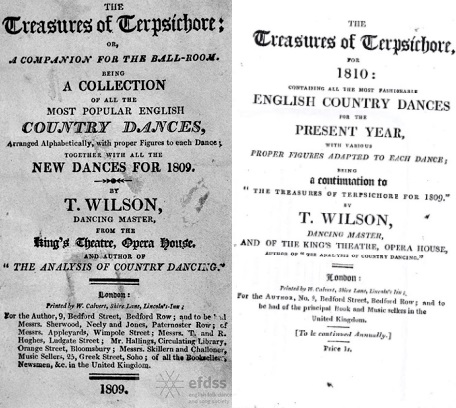
Figure 7. Thomas Wilson's 1809 Treasures of Terpsichore, and the 1810 Supplement. Both courtesy of the English Folk Dance and Song Society.
The book was printed by W. Calvert and sold through a network of booksellers named on the cover of the first edition, amongst whom Skillern & Challoner were the only specialist music shop to be named (see Figure 7). It contained suggested choreographies for a broad range of Country Dancing tunes, arranged personally by Wilson, and adapted to his own mode of teaching. The Supplements printed for 1810 and 1811 listed the publishers from whom the music for each dance could be purchased, a list of roughly 10 music shops; a footnote in the 1810 supplement added that The Music to the Dances in the Treasures of Terpsichore for 1809, may be had of Messrs Skillern and Co . This suggests that Skillern & Challoner were the direct source of the 200 or so tunes in the main 1809 publication.
Wilson explained in his preface that most other collections of dances were filled with such butterfly Dances as exist only in the brain of the publisher or engraver , and that his book contains all the good old Dances that have stood the test of time, such as the College Hornpipe, and Haste to the Wedding, names which perhaps will as much shock the ear of the Beau Monde as the Labyrinth, , Nameless, and Ridicule, would surprise the rustic natives of the Wolds of Sussex . It was unusual to combine old favourite tunes (no longer used in fashionable circles) alongside newly popular tunes as yet unknown outside of London.
Wilson claimed to have a good opinion of rustic dancers, they were alleged to be more adventurous and correct in their country dancing than the metropolitan dancers taught by London's professional dancing masters. He went on to explain that In our modern assemblies, a Dance composed of more than two parts, or what is called a single figure, generally gains the reception of a bad play, or rather worse, it is damned at its announcement . Dancers evidently did not want the complexity of a non-trivial dancing figure. He added: It indeed appears now, in fashionable life, a crime to attempt any thing that requires a capacity beyond what the more sagacious brutes are endowed with; for bad Dancing is now considered as strong proof of good breeding and that once delightful amusement will shortly dwindle into mere running, and that beautiful regularity of movement, which should always be displayed in a Country Dance, [will] be perverted into a chaos of riot and confusion . Wilson intended to rectify this situation.
For each of his named tunes Wilson would typically list two sets of figures, one arranged in a Single format, and one as a Double; the Double arrangement saw the tune being repeated such that longer figures could be combined into a more challenging and satisfying sequence. He added a clarification: By these remarks, I do not wish to be understood that I would recommend long figures for all companies; no, I consider short figures for large assemblies far more appropriate than long ones, not being so fatiguing, and giving more of the company an opportunity to call Dances. Not but any Lady, if she be so disposed, has a just right, even in a large assembly, to call a Dance to a double figure, unless previously informed to the contrary by the Master of the Ceremonies .
Wilson had previously published his Analysis of Country Dancing in 1808, a work that systematically documented his ideas about Country Dancing. The 1809 Treasures of Terpsichore took this system a step further, and applied it practically; Wilson choreographed suggested sequences of figures that would suit the music of the popular tunes used in Britain's Assembly Rooms. Dancers could use his figures, secure in the knowledge that they were well suited to the named tunes (unlike the experience one might expect from the typical country dance collections, including those of Skillern & Challoner, where the tune and figures were not certain to fit together even though they were printed next to each other!). Wilson would go on to publish choreographies on the same premise through the rival business of Button & Whitaker from 1812, but this publication is where he started.
Wilson's assertion that the tunes were available for purchase from Skillern & Challoner is intriguing. If the tunes named in The Treasures of Terpsichore for 1809 are compared to those known to have been published by Skillern & Challoner, a great many gaps will be found; that is, Wilson referenced tunes not found in any known Skillern & Challoner branded publication (including the 18th Century collections potentially inherited from Skillern's Uncle). This may imply that additional Country Dance tune collections once existed that are now lost, or that music published by other music shops was available for sale through Skillern & Challoner, or indeed that Wilson's statement was inaccurate. It seems likely that music shops would stock each other's publications, so long as there was money to be made from doing so; I therefore suspect that publications from other vendors could be bought from Skillern & Challoner in a reciprocal cross-selling agreement.
Venua & Deshaynes' French Country Dances, c.1815
Skillern & Challoner published musical works by many composers, one particularly interesting example was advertised in 1816 as French Dances by F. Venua (Morning Post, 23rd July 1816, see Figure 9), the same advertisement promoted Challoner's arrangements of Paine's Quadrilles (which are discussed further below). The full title of what was probably the same work was Six New French Country Dances, with Figures by Mr Deshaynes, Composed & Respectfully Dedicated to Miss Johnston, by F. Venua (see Figure 8). It was one of the first sets of Quadrilles to be published in London, though the term Quadrille does not feature in the title of the work itself.
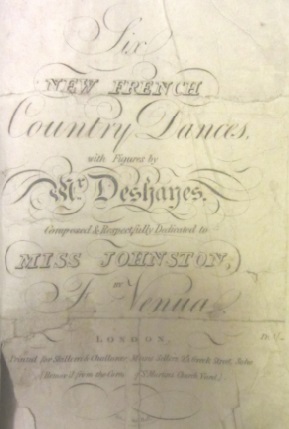
Figure 8. Six New French Country Dances, c.1815, by Venua and Deshaynes; printed for Skillern and Challoner.
There is a curious mystery over the date of publication for this work. Its cover indicates that Skillern & Challoner were still at their older address of 25 Greek Street, Soho; whereas, the newspaper advertisement quoted above has them at their new address of 138 Oxford Street. It's possible that this work was engraved and published in late 1815 while they were still at their older address, and was only mentioned in the 1816 advert as it was still in stock, and was relevant to the Quadrilles that were being advertised. If it does date to 1815 that makes the work even more interesting, it would date to just before the Quadrille's rapid increase in popularity. Later Skillern & Challoner publications (such as their 1st Set of The Favorite French Quadrilles) advertised the availability of a further collection of Six new French Dances Composed by F. Venua, with figures by Monsr Simon , the Simon collaboration might have been the work advertised in 1816, this adds credibility to an 1815 date for the Deshaynes collaboration seen in Figure 8.
Frédéric Venua was a principal composer for the King's Theatre Opera House, admitted to the Royal Society of Musicians in 1810. He didn't publish exclusively through Skillern & Challoner at this date; for example, another Set of Dances, by Venua, of six different Nations had been advertised through Falkner's Opera Music Warehouse just a few days before the 23rd July advert quoted above (Morning Post, 19th July 1816). Falkner also went on to advertise a Set of French Cotillions, by Venua a month later (Morning Post, 10th August 1816), this publication may also have been the same work as that published through Skillern & Challoner. The mixture of terminology between Quadrille , Cotillion and French Country Dance for what were related works (potentially the same work) is indicative of the general uncertainty surrounding the new dance form which was rapidly gaining popularity in London c.1816 - the standard vocabulary had yet to emerge.
Venua had worked for the King's Theatre since at least 1806 alongside one of their principal dancers, André-Jean-Jacques Deshayes. An 1806 advertisement links their names in a list of new music: Les Jardiniers, a beautiful Divertisement as performed at the King's Theatre by Deshaynes, Mareau, and Madam Parisot, composed for the Piano Forte by F Venua (Morning Chronicle, 9th July 1806). The music of Venua and dancing of Deshaynes were regularly mentioned in play-bills for the King's Theatre over the following decade. By late 1815 Venua was advertising his services as a dancing master, for example: Mr F Venua, from the Opera House, a Pupil of the celebrated Mr Coulon, at Paris, and who was professionally educated by Mr Vestris, offers his services to the Nobility and Gentry, and to the Principals at the Public Seminaries at Windsor and its vicinity, to instruct in the art of Dancing. Mr Venua feels more confidence in offering himself, as his abilities have been approved by Mr. D'Egville, to whom he refers those who may honour him with their confidence. N.B. Mr V. visits Windsor once a Week, and can devote part of the Day in attending private Families (Windsor & Eton Express, 10th December 1815). In 1816 he hosted a concert at Basingstoke of which was written: Of this gentleman's musical talents little need be said, when we observe that his compositions have stood the test of criticism at that high tribunal of taste and judgement, the Opera-house, London (Hampshire Chronicle, 29th July 1816). He hosted a dancing academy in Cambridge in October 1816 (Cambridge Chronicle & Journal, 17th September 1816), and continued to teach dancing into the 1820s and well beyond.
The choreography of Venua's French Dances of c.1815 (as published by Skillern & Challoner) was credited to Mr Deshaynes, one of the most famous stage dancers of his generation. The figures are typical Quadrille dancing figures, the dances consist of: No 1 La Bien Aime, No 2 La Sophie, No 3 La Nouvelle Etté, No 4 Les Deshayes, No 5 La Deidamie, No 6 La Renommeé. They're a reasonably nice set of social dances, interesting for linking the new dance form with the professional stage dancing of the Opera House. The presumably later set choreographed by Monsr Simon were also linked to the King's Theatre, H. Simon being a dancer at the theatre who published at least three sets of Quadrilles in 1816 (Morning Post, 14th August 1816), and three more in 1817, and would go on to publish at least 17 further sets from Dublin in the early 1820s. The presence of Venua's French Country Dances in the Skillern & Challoner catalogue at such an early date hint that the shop was at the leading edge of the new dancing trend.
Skillern & Challoner's Quadrilles
Skillern & Challoner published at least 11 sets of The Favorite French Quadrilles, with their Proper Figures in French & English, as Performed by Paines Band, &c., and Danced at Almacks, The Argyle Rooms, and all the Assemblies of the Nobility, &c. Adapted to the Piano Forte, With an Accompaniment ad libitum Expressly for the Harp, Arranged by N.B. Challoner . The first such Set was advertised as being available in July 1816 (Morning Post, 23rd July 1816, see Figure 9): THE New FRENCH QUADRILLES, as danced at all Private and Public Assemblies, adapted to the Pianoforte, with a Harp accompaniment, and with their proper Figures . They were still being produced in 1818 (Morning Post, 30th January) where they were advertised as The Quadrilles, as performed by Paine's Band, with Harp Accompaniments, 3s each Set .

Figure 9. French Quadrilles, Morning Post, 23rd July 1816. Image © THE BRITISH LIBRARY BOARD. ALL RIGHTS RESERVED. Image reproduced with kind permission of The British Newspaper Archive ( www.britishnewspaperarchive.co.uk)
The referenced Paine's Band was that of James Paine, his band played at Almack's Assembly Rooms and were at the epicentre of the British Quadrille dancing movement. We've written about James Paine and his band before, they were so closely associated with the rise of the Quadrille that for many people Paine's Band would have been almost synonymous with The Quadrille .
I've been able to study some of the Challoner Quadrille arrangements, including his first four sets; these four are duplicates of the Sets published by Paine, but with a different accompaniment composed by Challoner himself. It's likely that they had used Paine's name without authorisation, Paine published his own authorised version of his Quadrilles from 1816 through H. Falkner's Opera Music Warehouse, adding: Persons wishing to have Paine of Almack's Quadrilles, are requested to observe that Mr Paine's Signature is written on them, and no others are genuine, which will prevent imposition, as a Spurious Edition of the Quadrilles, has lately been Published , and in some editions: Mr Paine feels it an incumbent duty he owes the Public and himself, to prevent further imposition ... to caution them against a spurious Edition of Quadrilles, which has been published, the Title of them expressing to have been performed by Paine's Band, which is a gross imposition, as many of them never were performed by him; and the Accompaniments to them are very different to the original, which completely alters the Airs, and spoils the effect. . There can be little doubt that Paine was complaining, at least in part, of Challoner's variant versions of his Quadrilles; Paine's complaint may have been more general however, as other apparently unlicensed editions of his tremendously popular Quadrilles were also in circulation.
Challoner's 9th through 11th Sets of Quadrilles were not copied from Paine; these publications continued to reference Paine's Band on their covers, but they did not duplicate his music. These later Quadrille Sets appear to have been new works; the music for one of them, the 10th Set, was declared to have been composed by an Edward Parrish (of whom I know nothing more).
It appears that Skillern & Challoner were at the forefront of British Quadrille publishing from 1816. It's possible that they thought their promotion of Paine's Band would be welcomed; but whether it was an innocent misunderstanding or not, they are likely to have sowed discord with an important and influential band leader who intended to profit from the booming Quadrille industry himself. I know of no evidence for legal proceedings against Skillern & Challoner, but it's likely that Paine would have used his influence to damage their reputation. Nonetheless, they published Quadrilles through to at least 1818, and continued in business until 1825. Their creation of new dance publications seem to have ceased c.1818, there's little evidence of new compositions thereafter... I can only speculate at a reason, but the presumed quarrel with James Paine is a possible cause of this change.
Skillern & Challoner's Dance Publications
I've been able to study most of the Skillern & Challoner publications by combining the excellent archives at the British Library with those of the English Folks Dance and Song Society. A few of the collections are available on the Web, but most aren't. If you are lucky enough to own copies of any of these collections, and are willing to share them, do please Contact Us. We'd love for more of this material to be available to enthusiasts to enjoy without having to visit a research library!
| Work & Date | Image | Comments |
No 1, A Favorite Collection of Popular Country Dances
c.1806 |

|
The contents are: Lord Collingwood, Caro dolce, Love and Whiskey, The Honey Moon, Bognor Rocks, The Bedford Jig, Sir J.T. Duckworth Waltz, Lady Susan Hamilton.
Full Title: No 1, A Favorite Collection of Popular Country Dances, Arranged for the Piano Forte, Violin, &c. With their Proper Figures. "each Number is Selected, as to contain the Variety of a Strathspey, Reel, Waltz, Jig, Hornpipe, &c." Pr. 1s.
Image © THE BRITISH LIBRARY BOARD, g.230.cc ALL RIGHTS RESERVED
|
No 2, A Favorite Collection of Popular Country Dances
c.1806 |
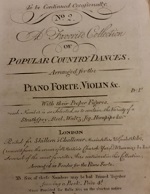
|
The contents are: Lord Moira's Welcome to Scotland, Cape Trafalgar, Lord Nelsons Victory, Miss Johnston, Lord Granthams Whim, Lady Montgomery.
Full Title: No 2, A Favorite Collection of Popular Country Dances, Arranged for the Piano Forte, Violin, &c. With their Proper Figures. "each Number is Selected, as to contain the Variety of a Strathspey, Reel, Waltz, Jig, Hornpipe, &c." Pr. 1s.
Image © THE BRITISH LIBRARY BOARD, g.230.cc ALL RIGHTS RESERVED
|
No 3, A Favorite Collection of Popular Country Dances
c.1807 |
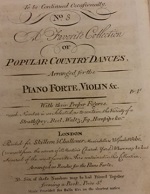
|
The contents are: Miss Belingcrofts Waltz, The Tars of the Victory, The Duchess of Bedfords Waltz, Lady Clementina, The Travellers or There with fun we the stocking throw, Miss Maxwells Reel, St Kildare.
Full Title: No 3, A Favorite Collection of Popular Country Dances, Arranged for the Piano Forte, Violin, &c. With their Proper Figures. "each Number is Selected, as to contain the Variety of a Strathspey, Reel, Waltz, Jig, Hornpipe, &c." Pr. 1s.
Image © THE BRITISH LIBRARY BOARD, g.230.cc ALL RIGHTS RESERVED
|
No 4, A Favorite Collection of Popular Country Dances
c.1807 |
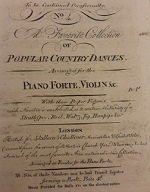
|
The contents are: Ap Shenkin, Miss Boyn or Knole Park, Tekeli, Paddy O Carrol, Mother Goose, Fly by Night, The Albion Assembly, Foley House.
Full Title: No 4, A Favorite Collection of Popular Country Dances, Arranged for the Piano Forte, Violin, &c. With their Proper Figures. "each Number is Selected, as to contain the Variety of a Strathspey, Reel, Waltz, Jig, Hornpipe, &c." Pr. 1s.
Image © THE BRITISH LIBRARY BOARD, g.230.cc ALL RIGHTS RESERVED
|
No 5, A Favorite Collection of Popular Country Dances
c.1807 |
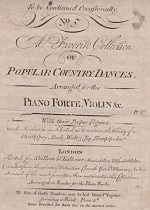
|
The contents are: The Fairy Dance, Miss Ray, or Shaddie, Tommy Pringle, The Nameless, The Labyrinth, The Ridicule, a Cotillion, Sir Richard Strachan, or the Wapping Assembly.
Full Title: No 5, A Favorite Collection of Popular Country Dances, Arranged for the Piano Forte, Violin, &c. With their Proper Figures. "each Number is Selected, as to contain the Variety of a Strathspey, Reel, Waltz, Jig, Hornpipe, &c." Pr. 1s.
|
No 6, A Favorite Collection of Popular Country Dances
c.1808 |
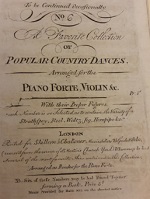
|
The contents are: Times a tell Tale, Trafalgar Hornpipe, The Brighton Waltz, South Downs, New Claret, Paddy O Connor, The Emperor of Hayti or King of the Catties.
Full Title: No 6, A Favorite Collection of Popular Country Dances, Arranged for the Piano Forte, Violin, &c. With their Proper Figures. "each Number is Selected, as to contain the Variety of a Strathspey, Reel, Waltz, Jig, Hornpipe, &c." Pr. 1s.
Image © THE BRITISH LIBRARY BOARD, g.230.cc ALL RIGHTS RESERVED
|
No 7, A Favorite Collection of Popular Country Dances
c.1808 |
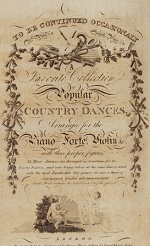
|
The contents are: The Runaway, Miss Parkinsons Strathspey, Ride a Mile, Miss or Major Spicer, The Wolds of Sussex, Kinloch of Kinloch, Captain Fleming.
Full Title: No 7, A Favorite Collection of Popular Country Dances, Arranged for the Piano Forte, Violin, &c. With their proper figures.
Image © VWML, EFDSS
|
No 8, A Favorite Collection of Popular Country Dances
c.1809 |
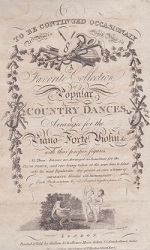
|
The contents are: Morgiana, Montreal, The Exile, Lord Cathcart, Calabria, Prime of Life, The Spanish Patriots.
Full Title: No 8, A Favorite Collection of Popular Country Dances, Arranged for the Piano Forte, Violin, &c. With their proper figures.
|
No 9, A Favorite Collection of Popular Country Dances
c.1809 |
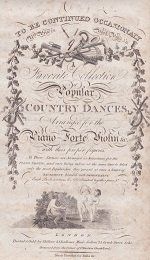
|
The contents are: The Happy Return, Lord Cochrane, Flora McDonald, The Russian Dance, The Italian Momfrina, The Stralsund Waltz, The new Spanish Patriots, Whiskey for ever.
Full Title: No 9, A Favorite Collection of Popular Country Dances, Arranged for the Piano Forte, Violin, &c. With their proper figures.
|
No 10, A Favorite Collection of Popular Country Dances
c.1810 |

|
The contents are: The Jubilee, Morgiana in Ireland, La Terza, The Sylph, The Bowery, Prince or Princess Dolgorucki.
Full Title: No 10, A Favorite Collection of Popular Country Dances, Arranged for the Piano Forte, Violin, &c. With their proper figures.
|
No 11, A Favorite Collection of Popular Country Dances
c.1810 |
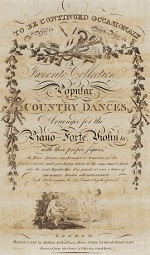
|
The contents are: Ricardo or the Persian Dance, Kimly Park, Harlequin Pedler, Tarry awhile with me, Fairy Revels, The Free Knights, Mrs. Suttleworth or Miss Woodthorpe, Crop the Croppies.
Full Title: No 11, A Favorite Collection of Popular Country Dances, Arranged for the Piano Forte, Violin, &c. With their proper figures.
Image © VWML, EFDSS
|
No 12, A Favorite Collection of Popular Country Dances
c.1810 |
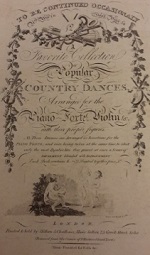
|
The contents are: Mrs. or Miss Millett, The Dorset Waltz, The much admired Boleros (as danced by Monsr. Vestris & Sigra. Angiolini in the favorite Spanish divertisment), Miss Crawfords Reel, Zephyr & Flora, The Decemvirate.
Full Title: No 12, A Favorite Collection of Popular Country Dances, Arranged for the Piano Forte, Violin, &c. With their proper figures.
Image © THE BRITISH LIBRARY BOARD, g.230.cc ALL RIGHTS RESERVED
|
No 13, A Favorite Collection of Popular Country Dances
c.1810 |
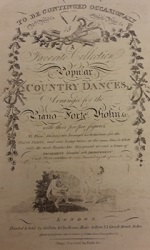
|
The contents are: St Julians Cottage, Lord Wellingtons Hornpipe, Madame Angiolinis Waltz, Seven in a Coach, Miss Linny, Patrick O Kelly.
Full Title: No 13, A Favorite Collection of Popular Country Dances, Arranged for the Piano Forte, Violin, &c. With their proper figures.
Image © THE BRITISH LIBRARY BOARD, g.230.cc ALL RIGHTS RESERVED
|
No 14, A Favorite Collection of Popular Country Dances
c.1811 |
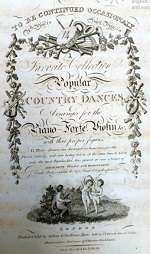
|
The contents are: Juliana, Talevera, The Tyrolese or Opera Hat, Bowman's Lodge or Culvers Lodge, Orsterly Park (by E.P.), Loch Lomond.
Full Title: No 14, A Favorite Collection of Popular Country Dances, Arranged for the Piano Forte, Violin, &c. With their proper figures.
Image © VWML, EFDSS
|
No 15, A Favorite Collection of Popular Country Dances
c.1812 |
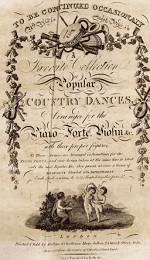
|
The contents are: The favorite Guaracha Dance (as Danced by Miss Smith), The Lady of the Lake, I'll gang na mare to yon town (This Tune was called for by His R.H. the PRINCE REGENT at the GRAND FETE given at CARLTON HOUSE), Lord Pagets Waltz, General Graham, Chalfont House.
Full Title: No 15, A Favorite Collection of Popular Country Dances, Arranged for the Piano Forte, Violin, &c. With their proper figures.
Image © VWML, EFDSS
|
No 16, A Favorite Collection of Popular Country Dances
c.1812 |
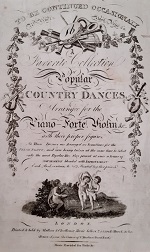
|
The contents are: Voulez vous Dansez Mademoiselle, or the Portuguese Dance, The Woodbine, Madame Catalanis Waltz, The Muses, Lady Bruce, The Tank, Morgiana in Spain.
Full Title: No 16, A Favorite Collection of Popular Country Dances, Arranged for the Piano Forte, Violin, &c. With their proper figures.
|
No 17, A Favorite Collection of Popular Country Dances
c.1812 |
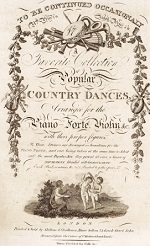
|
The contents are: The Recovery, Marian, The Prince Regent, Badajoz, The Clan Alpine Strathspey, Vestris's Gavotte, Drops of Whiskey.
Full Title: No 17, A Favorite Collection of Popular Country Dances, Arranged for the Piano Forte, Violin, &c. With their proper figures.
Image © VWML, EFDSS
|
No 18, A Favorite Collection of Popular Country Dances
c.1812 |
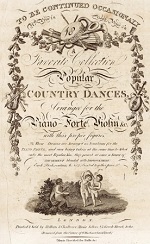
|
The contents are: The Copenhagen or Vauxhall Waltz, The Knights of Snowdoun, Bateuse (a much celebrated French Dance), Salamanca, Lord Wellingtons Waltz, La Mozart, The English Heroes in Spain.
Full Title: No 18, A Favorite Collection of Popular Country Dances, Arranged for the Piano Forte, Violin, &c. With their proper figures.
Image © VWML, EFDSS
|
No 19, A Favorite Collection of Popular Country Dances
c.1813 |
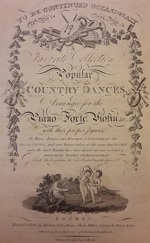
|
The contents are: Mrs. Macleod of Razy, Miss Johnstons Waltz, The Isle of Skye, Vittoria, Miss Platoff, Prince Kutusoff, The Cosack.
Full Title: No 19, A Favorite Collection of Popular Country Dances, Arranged for the Piano Forte, Violin, &c. With their proper figures.
Image © THE BRITISH LIBRARY BOARD, h.925.o ALL RIGHTS RESERVED
|
No 20, A Favorite Collection of Popular Country Dances
c.1814 |
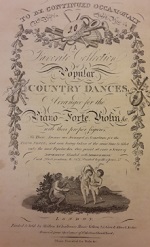
|
The contents are: Enrico, Leipzig, Orange Boven, Lady Caroline Bertie, Lord Saint Oswald, Birnie Waltz, Cupid in Ireland.
Full Title: No 20, A Favorite Collection of Popular Country Dances, Arranged for the Piano Forte, Violin, &c. With their proper figures.
Image © THE BRITISH LIBRARY BOARD, h.925.o ALL RIGHTS RESERVED
|
No 21, A Favorite Collection of Popular Country Dances
c.1814 |
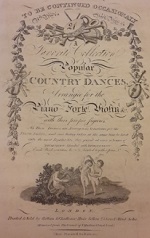
|
The contents are: The Zapateado, The Cachucha, Count Platoffs Waltz, The Saxon Dance, Miss Gaytons Hornpipe, or the Emperors welcome, Orange Boven, Arabella, Prince Blucher.
Full Title: No 21, A Favorite Collection of Popular Country Dances, Arranged for the Piano Forte, Violin, &c. With their proper figures.
Image © THE BRITISH LIBRARY BOARD, h.925.o ALL RIGHTS RESERVED
|
No 22, A Favorite Collection of Popular Country Dances
c.1815 |
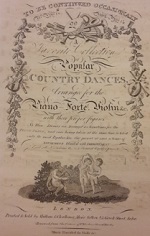
|
The contents are: Six Waltzes.
Full Title: No 22, A Favorite Collection of Popular Country Dances, Arranged for the Piano Forte, Violin, &c. With their proper figures.
Image © THE BRITISH LIBRARY BOARD, h.925.o ALL RIGHTS RESERVED
|
1st Set of The Favorite French Quadrilles
1816 |

|
This Quadrille Set duplicates the contents of James Paine's 1st Set, with an alternative accompaniment supplied by Challoner.
The contents are: La Paysanne, La Flora, Le Cobourg, La Felesia, La Pastorale, La Nouvelle Chasse.
Full Title: 1st Set of The Favorite French Quadrilles, With their Proper Figures, in French & English as Performed by Paines Band, &c. and Danced at Almacks, The Argyll Rooms, and all the Assemblies of the Nobility, &c. Adapted to the Piano Forte, with an Accompaniment ad libitum Expressly for the Harp, Arranged by N.B. Challoner. Price 3s.
Image © THE BRITISH LIBRARY BOARD, h.306.a ALL RIGHTS RESERVED
|
2nd Set of The Favorite French Quadrilles
c.1816 |
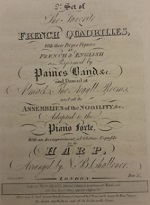
|
This Quadrille Set duplicates the contents of James Paine's 2nd Set, with an alternative accompaniment supplied by Challoner.
The contents are: La Penelope, La Daphne, La Poulle Anglaise, La Theresia, Le Wellington, Les Echo's.
Full Title: 2nd Set of The Favorite French Quadrilles, With their Proper Figures, in French & English as Performed by Paines Band, &c. and Danced at Almacks, The Argyll Rooms, and all the Assemblies of the Nobility, &c. Adapted to the Piano Forte, with an Accompaniment ad libitum Expressly for the Harp, Arranged by N.B. Challoner. Price 3s.
Image © THE BRITISH LIBRARY BOARD, h.306.a ALL RIGHTS RESERVED
|
3rd Set of The Favorite French Quadrilles
c.1816 |
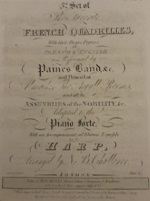
|
This Quadrille Set duplicates the contents of James Paine's 3rd Set, with an alternative accompaniment supplied by Challoner.
The contents are: La Lisette, La Villageoise, La Matilda, L'Eugene, L'Hereuse Fantasie, Les Graces.
Full Title: 3rd Set of The Favorite French Quadrilles, With their Proper Figures, in French & English as Performed by Paines Band, &c. and Danced at Almacks, The Argyll Rooms, and all the Assemblies of the Nobility, &c. Adapted to the Piano Forte, with an Accompaniment ad libitum Expressly for the Harp, Arranged by N.B. Challoner. Price 3s.
Image © THE BRITISH LIBRARY BOARD, h.306.a ALL RIGHTS RESERVED
|
4th Set of The Favorite French Quadrilles
c.1816 |
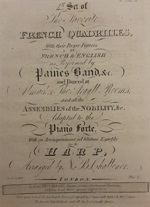
|
This Quadrille Set duplicates the contents of James Paine's 4th Set, with an alternative accompaniment supplied by Challoner.
The contents are: La Magdonal, La Nouvelle Ete, La Non Chalant, La Nouvelle Pastoralle, La Veritable Chasse.
Full Title: 4th Set of The Favorite French Quadrilles, With their Proper Figures, in French & English as Performed by Paines Band, &c. and Danced at Almacks, The Argyll Rooms, and all the Assemblies of the Nobility, &c. Adapted to the Piano Forte, with an Accompaniment ad libitum Expressly for the Harp, Arranged by N.B. Challoner. Price 3s.
Image © THE BRITISH LIBRARY BOARD, h.306.a ALL RIGHTS RESERVED
|
5th Set of The Favorite French Quadrilles
c.1817 |
|
|
6th Set of The Favorite French Quadrilles
c.1817 |
|
|
7th Set of The Favorite French Quadrilles
c.1817 |
|
|
8th Set of The Favorite French Quadrilles
c.1817 |
|
|
9th Set of The Favorite French Quadrilles
c.1818 |
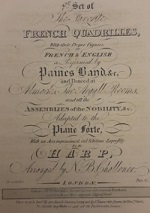
|
The contents are: Le Leopold, L'Emilie, La Rousseau, La Henrietta, L'Adelaide.
Full Title: 9th Set of The Favorite French Quadrilles, With their Proper Figures, in French & English as Performed by Paines Band, &c. and Danced at Almacks, The Argyll Rooms, and all the Assemblies of the Nobility, &c. Adapted to the Piano Forte, with an Accompaniment ad libitum Expressly for the Harp, Arranged by N.B. Challoner. Price 3s.
Image © THE BRITISH LIBRARY BOARD, h.306.a ALL RIGHTS RESERVED
|
10th Set of The Favorite French Quadrilles
c.1818 |
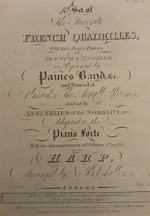
|
A message within this publication reads: The airs in the following Quadrille are composed & respectfully dedicated to Mrs Collins, by Ed Parrish (No 8, Upper Marylebone Strt) .
The contents are: La Rosalie, La Louisa, La Julia, La Isabella, La Frederica.
Full Title: 10th Set of The Favorite French Quadrilles, With their Proper Figures, in French & English as Performed by Paines Band, &c. and Danced at Almacks, The Argyll Rooms, and all the Assemblies of the Nobility, &c. Adapted to the Piano Forte, with an Accompaniment ad libitum Expressly for the Harp, Arranged by N.B. Challoner. Price 3s.
Image © THE BRITISH LIBRARY BOARD, h.306.a ALL RIGHTS RESERVED
|
11th Set of The Favorite French Quadrilles
c.1818 |
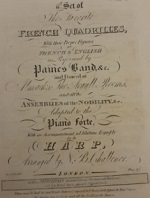
|
The contents are: Le Pantalon, L'Ete, La Poule, La Trenise, La Finale.
Full Title: 11th Set of The Favorite French Quadrilles, With their Proper Figures, in French & English as Performed by Paines Band, &c. and Danced at Almacks, The Argyll Rooms, and all the Assemblies of the Nobility, &c. Adapted to the Piano Forte, with an Accompaniment ad libitum Expressly for the Harp, Arranged by N.B. Challoner. Price 3s.
Image © THE BRITISH LIBRARY BOARD, h.306.a ALL RIGHTS RESERVED
|
We'll end this investigation here. If you have further information to share, or access to some of the missing publications, or would otherwise like to talk to us, do please Contact Us - we're always keen to learn more.
|


 Figure 1. August 1st 1806, Print accompanying a Song, music for which was sold by Skillern & Challoner. Courtesy of the Lewis Walpole Library, Yale.
Figure 1. August 1st 1806, Print accompanying a Song, music for which was sold by Skillern & Challoner. Courtesy of the Lewis Walpole Library, Yale.
 Figure 2. 25 Greek Street, Soho, from the Horwood map of 1792-9. © THE BRITISH LIBRARY BOARD, HUS 050.
Figure 2. 25 Greek Street, Soho, from the Horwood map of 1792-9. © THE BRITISH LIBRARY BOARD, HUS 050.
 Figure 3. Auction of Skillern & Challoner's assets, Morning Advertiser, 19th September 1825.
Image © THE BRITISH LIBRARY BOARD. ALL RIGHTS RESERVED. Image reproduced with kind permission of The British Newspaper Archive (www.britishnewspaperarchive.co.uk).
Figure 3. Auction of Skillern & Challoner's assets, Morning Advertiser, 19th September 1825.
Image © THE BRITISH LIBRARY BOARD. ALL RIGHTS RESERVED. Image reproduced with kind permission of The British Newspaper Archive (www.britishnewspaperarchive.co.uk).
 Figure 4. Example Skillern & Challoner Dance Collections, No 5 and No 8.
Figure 4. Example Skillern & Challoner Dance Collections, No 5 and No 8.
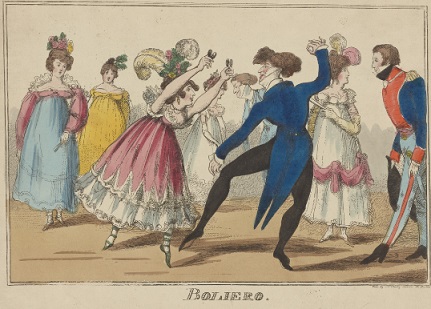 Figure 5. Boliero, c.1809. Courtesy of The New York Public Library.
Figure 5. Boliero, c.1809. Courtesy of The New York Public Library.
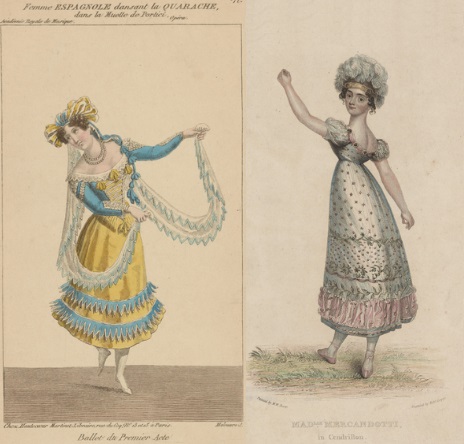 Figure 6. Left: A Guaracha dance, c.1828, courtesy of The New York Public Library. Right: Mad'lle Mercandotti as Cinderella, 1822, courtesy of The New York Public Library.
Figure 6. Left: A Guaracha dance, c.1828, courtesy of The New York Public Library. Right: Mad'lle Mercandotti as Cinderella, 1822, courtesy of The New York Public Library.
 Figure 7. Thomas Wilson's 1809 Treasures of Terpsichore, and the 1810 Supplement. Both courtesy of the English Folk Dance and Song Society.
Figure 7. Thomas Wilson's 1809 Treasures of Terpsichore, and the 1810 Supplement. Both courtesy of the English Folk Dance and Song Society.
 Figure 8. Six New French Country Dances, c.1815, by Venua and Deshaynes; printed for Skillern and Challoner.
Figure 8. Six New French Country Dances, c.1815, by Venua and Deshaynes; printed for Skillern and Challoner.
 Figure 9. French Quadrilles, Morning Post, 23rd July 1816. Image © THE BRITISH LIBRARY BOARD. ALL RIGHTS RESERVED. Image reproduced with kind permission of The British Newspaper Archive (www.britishnewspaperarchive.co.uk)
Figure 9. French Quadrilles, Morning Post, 23rd July 1816. Image © THE BRITISH LIBRARY BOARD. ALL RIGHTS RESERVED. Image reproduced with kind permission of The British Newspaper Archive (www.britishnewspaperarchive.co.uk)